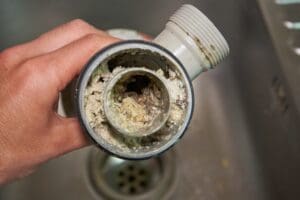The writer is making a number of good annotation relating to 4 Ways to Troubleshoot Low Water Pressure as a whole in the content underneath.

Low tide stress in your house can be a discouraging trouble, affecting every little thing from bathing to cleaning meals. If you're experiencing weak water circulation, there are numerous possible reasons and solutions to discover. In this guide, we'll review usual reasons for low water pressure and useful steps to address the issue successfully.
Intro to Low Water Pressure
Low water stress happens when the circulation of water from your faucets, showers, and various other components is weaker than normal. This can make everyday tasks extra difficult and less effective. Recognizing the causes of low tide stress is vital to discovering the best service.
Usual Reasons For Low Water Pressure
Pipe Obstructions
In time, pipelines can become blocked with mineral deposits, sediment, or debris, restricting the circulation of water. This is a typical problem in older homes with galvanized steel pipes.
Deterioration
Corrosion within pipelines can result in leaks and minimized water pressure. Corrosion accumulation can constrict water flow, particularly in aging plumbing systems.
Faulty Stress Regulators
Stress regulators are responsible for keeping constant water stress in your house. If they malfunction, it can lead to low tide pressure or irregular flow throughout your house.
Community Water Issues
Often, the problem lies outside your home. Metropolitan water supply concerns, such as main line leakages or upkeep work, can briefly lower water pressure in your area.
Exactly How to Diagnose Low Water Pressure
Checking Faucets and Fixtures
Beginning by testing the water stress at various faucets and components throughout your home. If the concern is separated to details locations, it may show localized issues.
Examining Pipes
Inspect noticeable pipelines for indications of leakages, corrosion, or obstructions. Focus on any unusual audios, such as banging or rattling pipes, which might show issues within the plumbing system.
Consulting with a Plumber
If you're not able to identify the cause of low water stress, take into consideration working with a specialist plumber to perform an extensive evaluation. They can recognize underlying problems and recommend ideal solutions.
Do It Yourself Solutions to Fix Low Tide Stress
Cleansing Aerators and Showerheads
Natural resources can gather in aerators and showerheads, decreasing water flow. Get rid of and clean these elements frequently to enhance water pressure.
Flushing Water Heater
Sediment buildup in the water heater can limit circulation and minimize effectiveness. Purging the container periodically assists get rid of sediment and keep optimal efficiency.
Inspecting Stress Regulatory Authority
Ensure that the stress regulatory authority is functioning correctly. Adjusting or changing the regulator can help recover proper water stress throughout your home.
Clearing Up Clogs in Pipeline
For small clogs, try utilizing a plumbing serpent or chemical drainpipe cleaner to clear blockages in pipes. Beware when using chemicals and comply with safety and security standards.
When to Call an Expert Plumber
If DIY efforts stop working to resolve the problem or if you believe substantial plumbing problems, it's ideal to look for aid from a qualified plumber. They have the knowledge and tools to address complex problems safely and effectively.
Safety Nets to Keep Water Stress
Routine Maintenance
Arrange regular maintenance for your plumbing system to stop concerns such as corrosion, leaks, and obstructions. Addressing small troubles early can aid prevent more significant fixings later on.
Mounting a Pressure Booster
Take into consideration mounting a stress booster pump to boost water pressure in locations with consistently low flow. This can be particularly valuable for multi-story homes or homes with high-demand fixtures.
Monitoring Water Use
Be mindful of water use practices and prevent ill-using the plumbing system. Straightforward changes, such as incredible showers and laundry loads, can assist keep adequate water pressure.
Conclusion
Managing low water pressure can be aggravating, but determining the underlying causes and applying ideal services can restore optimum flow throughout your home. Whether it's cleansing aerators, evaluating pipes, or seeking advice from a plumber, taking proactive actions can ensure a stable supply of water for your day-to-day needs.
FOUR WAYS TO FIX LOW WATER PRESSURE NOW
Turning on a shower or faucet only to find the water comes out in a sad, slow drizzle is never a good feeling. How exactly are you supposed to wash a pan or take a quick shower when it takes 10 minutes just to rinse off a little soap? The good news is that when your water pressure is bad, there's always a cause: typically one that can be easily fixed. Here are some of the most common causes of low pressure and what you can do to fix the issue:
DEBRIS AND MINERAL DEPOSIT BUILDUPS
If you notice low water pressure from just one or two of the fixtures in your house, the problem likely has to do with debris buildup. Water is full of minerals and other debris, all of which can accumulate in your pipes and on your fixtures. This can cause a blockage that affects how much water flows through. To fix this, try filling a small plastic bag with white vinegar, and use a rubber band to hang it around your showerhead or faucet. Let the head of the fixture soak for a few hours, and the vinegar should loosen the deposits.
WATER LEAKS
Leaks are another common cause of low water pressure. If water is flowing out of your plumbing through a hole or crack before it can reach your fixture, the pressure coming out of the faucet or showerhead will be lower. A plumbing professional is your best bet for finding and repairing a leak in your water supply pipes.
Leaks are another common cause of low water pressure. If water is flowing out of your plumbing through a hole or crack before it can reach your fixture, the pressure coming out of the faucet or showerhead will be lower. A plumbing professional is your best bet for finding and repairing a leak in your water supply pipes.
FOUR WAYS TO FIX LOW WATER PRESSURE NOW
Turning on a shower or faucet only to find the water comes out in a sad, slow drizzle is never a good feeling. How exactly are you supposed to wash a pan or take a quick shower when it takes 10 minutes just to rinse off a little soap? The good news is that when your water pressure is bad, there's always a cause: typically one that can be easily fixed. Here are some of the most common causes of low pressure and what you can do to fix the issue:
DEBRIS AND MINERAL DEPOSIT BUILDUPS
If you notice low water pressure from just one or two of the fixtures in your house, the problem likely has to do with debris buildup. Water is full of minerals and other debris, all of which can accumulate in your pipes and on your fixtures. This can cause a blockage that affects how much water flows through. To fix this, try filling a small plastic bag with white vinegar, and use a rubber band to hang it around your showerhead or faucet. Let the head of the fixture soak for a few hours, and the vinegar should loosen the deposits.
WATER LEAKS
Leaks are another common cause of low water pressure. If water is flowing out of your plumbing through a hole or crack before it can reach your fixture, the pressure coming out of the faucet or showerhead will be lower. A plumbing professional is your best bet for finding and repairing a leak in your water supply pipes.
Leaks are another common cause of low water pressure. If water is flowing out of your plumbing through a hole or crack before it can reach your fixture, the pressure coming out of the faucet or showerhead will be lower. A plumbing professional is your best bet for finding and repairing a leak in your water supply pipes.
A VALVE ISSUE
If you have low water pressure throughout your home, check your main shut-off valve to make sure it's completely open. You may also want to see if there's a pressure-reducing valve installed. If there is, have a plumber help you adjust the settings to get the pressure you're looking for.
OTHERS USING WATER
Believe it or not, your low water pressure could be caused by your neighbors. If you notice low pressure at certain times of day, it may be because you and the people living next to you have similar schedules - when everyone is showering at the same time, the pressure will be lower in every home. Low pressure throughout the neighborhood may also be caused by an issue with your municipal water supply. If that's the case, call the supplier to see if they're working on the issue.
https://www.rotorooter.com/blog/water-leaking/low-water-pressure-fixes/

We were shown that write-up about 10 Reasons for Low Water Pressure in Your House through a buddy on another blog. Do you know somebody else who is curious about Low Water Pressure in the House?? Why not promote it. Thank you for being here. Come back soon.
Get Your Estimate Now